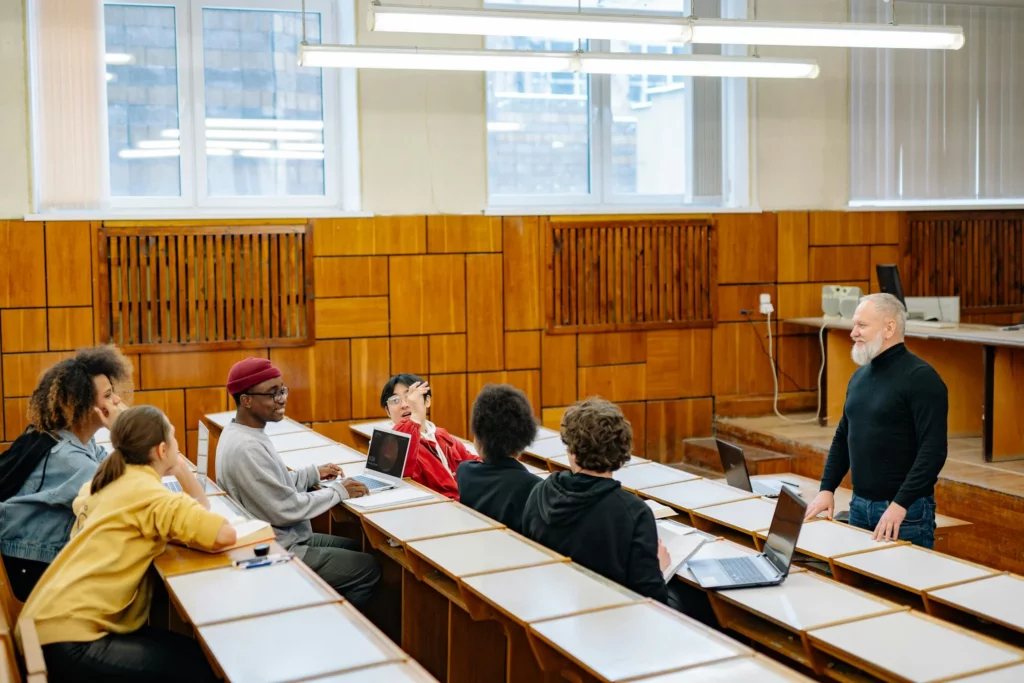Nov 1, 2023
Note: These tips were written with the undergraduate professor and students in a face-to-face full-time learning environment in mind. However, they can be equally valuable in the post-graduate, virtual learning, distance learning, and part-time university program setting.

Having experienced university teaching through lecture, most instructors teach how they have been taught. Although lecture (i.e., monologue instruction) can be an effective tool for learning, it can be over-used or not intentionally used to maximize learning. Well-designed dialogue, however, helps to cultivate an environment where respect, immediacy, safety, engagement, relevance, and inclusion take place.
Below are a few ways to shift your classroom from monologue to dialogue:
- Recognize the learner feels their power when they hear themselves being heard. Deeper learning happens when a student hears their own voice. Instead of sitting in a passive posture, they become active participants in dialogue. Monologue shuts down interaction, dialogue invites it. Sometimes it is inner dialogue that is needed; inviting “solo flights of thought” (as talked about in Quiet by Susan Cain, 2013).
- Don’t tell what you can ask; don’t ask if you know the answer, tell in dialogue. To do this well takes an intentional design and preparation. It is easier to stand at the front of the classroom and talk, but deeper learning takes place when students are invited to respond to questions or prompts that require multiple levels of analysis and synthesis. Invite your students into a dynamic learning experience that allows them to explore the content and make connections to their own lives.
- Prepare content and… The content of a course is important but equally important is what the learner is invited to do with that content. Learning by doing invites response and creates an atmosphere of support and challenge.
- Talk less, say more. Lecture can be a great tool when thoughtfully designed. Try to keep lectures short and, when new content is delivered, invite learners to engage with it. Sometimes professors feel the need to retell students what they read for homework. Instead, use class time to test, challenge, compare, debate, and analyze the new theories, concepts, tools, and research presented. Meaningful engagement will heighten learning.
- Trust your students. Utilize small groups for dialogue about content (readings, lectures, assignments, etc.) and know that if you have created a safe learning environment where meaningful engagement is being invited students will not disappoint you. As adults, they are responsible for their own learning and “force feeding” just won’t work.
- Use technology to enhance learning. Concise PowerPoint, short video, audio clips, and meaningful handouts are great tools to replace long lectures and to improve learning during short lectures. Consider how you might use such technology to bring content pieces into the classroom and invite student engagement. In other words, less is more.
- Engage learners in a variety of ways. Consider how you might engage visual, auditory, and kinesthetic learners. Design the delivery of your content so that multiple learning styles, temperaments, interests, and intelligences will be engaged. Learning about your students before and during your course will help you tap into the unique characteristics of your learners. (see tip sheet Dialogue Education in the University: Using a Learning Needs and Resources Assessment)
- Use open and digging-deeper questions. Stay away from closed questions that can be answered with yes or no. A well-designed open question goes a long way in stimulating dialogue. The classroom is energized when questions are constructed in a way that leads to engagement with both simple and complex issues. To encourage critical thinking, use “digging deeper” questions, such as “Say more about that,” or “What might be the causes of this situation?” or “What are the likely consequences?”
- Offer choice. Taking time to review and personalize the course syllabus invites choice. Asking students to choose some of their course readings, assignments, and deadlines invites choice. Meeting regularly to discuss goals, expectations, course work, and learning invites choice. Allowing students to sit where they wish and form their own work groups invites choice. All these choices = respect and relevance = more learning. (see tip sheet Dialogue Education in the University: Starting with the Syllabus)
- Arrange the space to maximize dialogue and learning. Sometimes sitting in a large circle will encourage deeper sharing and more courageous questions. Other times, sitting in small groups is what you want to stimulate creative thinking and deep engagement. Most often, sitting in rows will discourage dialogue and encourage passivity – and so should be avoided. We always want to ask ourselves: How should I set up the room to maximize learning? (see tip sheet Dialogue Education in the University: Creating the Environment for Learning)
What do you do in your college or university classroom to invite dialogue?
Jeanette Romkema is GLP Senior Consultant, Network Director and Co-owner. Jeanette has taught courses at Dordt College, Tyndale University College and Seminary, Emmanuel College of Victoria University of The University of Toronto, Summer Peacebuilding Institute of Eastern Mennonite University, Wheaton College, and Wycliffe College. She has also taught university professors how to strengthen their work with Dialogue Education in Ghana, USA and Canada. Read more blogs by Jeanette here.
Dan Haase is Internship Coordinator & Instructor at Wheaton College and works with his entire department to embrace Dialogue Education principles and practices in the university classroom. Read more blogs by Dan here.
Here are some GLP resources for teaching in academia:



